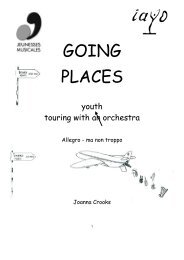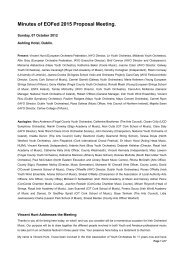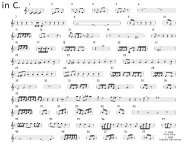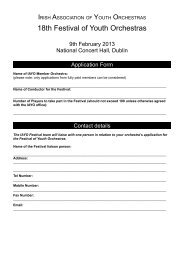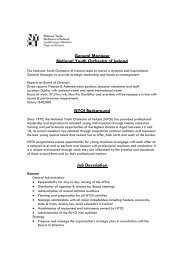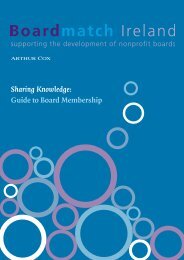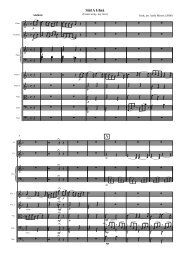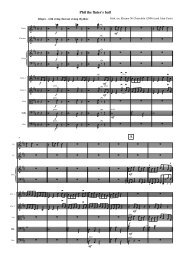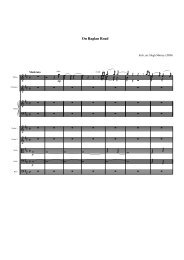A SOUND EAR II - Association of British Orchestras
A SOUND EAR II - Association of British Orchestras
A SOUND EAR II - Association of British Orchestras
You also want an ePaper? Increase the reach of your titles
YUMPU automatically turns print PDFs into web optimized ePapers that Google loves.
A <strong>SOUND</strong> <strong>EAR</strong> <strong>II</strong><br />
Equipment<br />
Measurement equipment shall meet the following specification:<br />
• Individual noise monitoring devices shall be designed to securely fix to the clothing <strong>of</strong> the musician without risk<br />
<strong>of</strong> damage to delicate clothing. Tripods shall not be used for mounting measurement equipment to measure noise<br />
exposure <strong>of</strong> musicians.<br />
• When attached, the device shall not cause any restriction to movement for the musician wearing it.<br />
• Devices shall be compliant with BS EN 61252:1997 Electroacoustics. Specifications for Personal Sound Exposure Meters.<br />
• Devices shall measure and record L Aeq<br />
up to at least 130dBL Aeq<br />
.<br />
• Devices shall measure and record peak levels up to at least 140dB(C).<br />
• Devices shall measure time histories <strong>of</strong> the above parameters averaged across 1 minute time intervals.<br />
• Devices shall not emit any noise during operation or standby.<br />
• Devices should not emit any light during operation. If light is emitted, the light source shall be covered with a nontranslucent<br />
tape during measurements.<br />
• All devices must be calibrated bi-annually using equipment referenced to the <strong>British</strong> Calibration Service, and the<br />
National Physical Laboratory.<br />
Examples <strong>of</strong> equipment which meets the requirements are:<br />
• Cirrus Research CR:110A doseBadge Person Noise Meter with RC:110A Reader Unit<br />
• Casella CEL-350 dBadge Noise Dosimeter<br />
In addition to the personal noise monitoring devices, a single sound level meter shall be mounted on a tripod next to<br />
the conductor’s desk, ensuring that the tripod does not restrict access to any <strong>of</strong> the performer positions. The sound<br />
level meter shall have all <strong>of</strong> the functionality described for the personal noise devices and shall comply with BS EN<br />
61672-1:2003 Electroacoustics. Sound level meters. Specifications.<br />
37<br />
Measurement Method<br />
All musicians shall be made aware <strong>of</strong> the dates <strong>of</strong> monitoring at least a week in advance. The specific musicians to be<br />
monitored shall arrive in good time before the start <strong>of</strong> the rehearsal or performance (ideally 15-20 minutes) to have<br />
their personal devices fitted.<br />
All clocks on the measurement devices shall be synchronised before fitting to musicians.<br />
To obtain a reasonable record <strong>of</strong> the sound level distribution in the pit, a minimum <strong>of</strong> seven personal devices shall<br />
be used, in addition to the sound level meter at the conductor’s position. For large orchestras, more devices are<br />
recommended.<br />
Personal devices shall be fitted to either shoulder <strong>of</strong> the musician as close to the ear as possible without restricting<br />
movement.<br />
Personal devices must remain running during intervals/breaks. They would preferably remain fixed to the musician<br />
during this time. Musicians should be aware that they do not record conversations, just statistical data. If devices are<br />
removed during such breaks, they must be refitted in the same location before playing recommences.<br />
If different works are performed during a single performance, the s<strong>of</strong>tware provided with the equipment shall be<br />
capable <strong>of</strong> isolating the different time histories for the different pieces.<br />
At the end <strong>of</strong> the session, devices must be left on music stands for collection by the noise monitoring coordinator.<br />
The calibration <strong>of</strong> all measurement equipment must be verified before and after use (using an internal acoustic<br />
calibrator to IEC 60942:2001 Class 2) and any observable drift noted.



